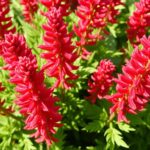Did you know the Japanese Timber Bamboo can grow up to 70 feet tall? This giant is just one of many plants that can turn your backyard into a peaceful Japanese garden. I’m excited to share five stunning plants that will bring the beauty of Japanese gardens to your home.
Japanese gardens are more than just plants. They’re a blend of nature, architecture, and spirituality. These gardens aim to create a peaceful retreat. They offer a zen-like space to escape daily life’s hustle.
In this guide, I’ll introduce you to five plants key for an authentic Japanese garden. From the iconic Japanese Maple to the low-growing Mondo Grass, each plant has a special role. They help create a tranquil outdoor space.
These plants work well in small city gardens or large suburban yards. They can help you achieve the look and feel of a traditional Japanese garden. Let’s explore how to add Eastern elegance to your Western landscape.
Key Takeaways
- Japanese gardens blend nature, architecture, and spirituality
- Five essential plants for an authentic Japanese garden
- Japanese Maple is an iconic centerpiece for gardens
- Mondo Grass provides excellent ground cover
- Japanese gardens focus on creating a peaceful, zen-like atmosphere
- These plants can adapt to various garden sizes and climates
- Proper plant selection helps achieve authentic Japanese garden aesthetics
Understanding the Essence of Japanese Gardens
Japanese gardens mix art and nature, showing off traditions and philosophies from centuries ago. I find it amazing how these gardens capture the zen and tranquility spirit. Let’s look at what makes Japanese gardens unique.
Key principles of Japanese garden design
Japanese garden design has its own set of rules that differ from Western styles. Unlike European gardens in the 18th century, which loved symmetry, Japanese gardens prefer asymmetry and natural shapes. They don’t use straight lines, making visitors explore the space on their own.
- Emphasis on asymmetry
- Use of enclosures
- Incorporation of borrowed scenery
- Balance of elements
- Symbolic representations
Symbolism and structure in Japanese gardens
Every part of a Japanese garden means something deeper. Rocks might stand for mountains, and trees trimmed just so show the flow of time. The idea of wabi-sabi, finding beauty in flaws, is clear in the aging of things like bridges.
Creating a calming atmosphere
The main aim of a Japanese garden is to be a peaceful spot. Water features, mossy grounds, and where plants are placed all add to the calm. These gardens teach us to enjoy the seasons and the fleeting nature of life.
| Garden Element | Symbolic Meaning |
|---|---|
| Rocks | Mountains or islands |
| Water | Life force or purity |
| Bridges | Path to paradise or self-improvement |
| Pine trees | Longevity and strength |
Learning about these principles has deepened my respect for Japanese gardens. They’re not just pretty places but also reflect Japanese culture and thought. They invite us to find peace in our hectic lives.
Japanese Maple: The Iconic Centerpiece
I’ve always been drawn to the beauty of Japanese maples. These trees are ideal for any Japanese garden. They add elegance and magic to outdoor spaces with their delicate leaves.
Japanese maples, or Acer palmatum, can reach up to 25 feet tall. They do well in USDA Hardiness Zones 5-9, fitting many areas in the U.S. These trees can handle different light levels, from full sun to partial shade.
When designing your Japanese garden, keep these points in mind about Japanese maples:
- They have graceful canopies that offer dappled shade.
- Their leaves change colors beautifully in the fall.
- They like moist, well-draining, acidic soil.
Japanese maples look great with other garden elements. Their leaves and the strong lines of bonsai trees create a perfect balance. Adding a water feature, like the Zen K2 Fountain, enhances their beauty. This fountain stands 92 inches tall and takes 3-5 weeks to arrive, offering various material choices.
| Feature | Japanese Maple | Zen K2 Fountain |
|---|---|---|
| Height | Up to 25 feet | 92 inches |
| Weight | Varies | 335 lbs |
| Material | Living tree | Corten, Powder coat steel, Stainless |
Adding Japanese maples and other elements creates a peaceful and beautiful Japanese garden. It offers joy throughout the year.
Camellia: Elegance in Bloom
In my japanese garden, camellias are a symbol of grace and beauty. These plants, with 100-300 species, have been in Chinese and Japanese gardens for centuries. I’m always amazed by their rich history and stunning variety.
Varieties of Camellia for Japanese Gardens
The Seattle Japanese Garden has over a dozen Camellia japonica varieties. My favorite is ‘Daikagura’, registered in 1891 and considered one of the greatest camellias. Its large, variegated flowers bloom in bright rose-red with white splotches, creating a peony-like appearance.
Care and Maintenance Tips
Camellias thrive in my garden from late January through early April. I make sure they get partial to full shade and moist, acidic soil. Regular pruning after they flower keeps them healthy and shapely.
Incorporating Camellia into Your Garden Design
I love placing camellias near cherry blossoms for a stunning contrast. Their evergreen foliage provides year-round interest, while their blooms offer a preview of spring’s beauty.
| Camellia Variety | Origin | Year Introduced | Notable Features |
|---|---|---|---|
| Purity | Japan | 1681 | Pure white blooms |
| Finlandia | U.S. | 1941 | Sport of ‘Finlandia Variegated’ |
| Amabilis | Japan | 1932 | Known as ‘Yukimi Guruma’ in Japan |
| Cheerful | U.S. | 1883 | Developed in Mississippi |
“The name ‘Daikagura’ might symbolize the transition from winter to spring, bringing the essence of shrines to viewers.”
Hakone Grass: Adding Texture and Movement
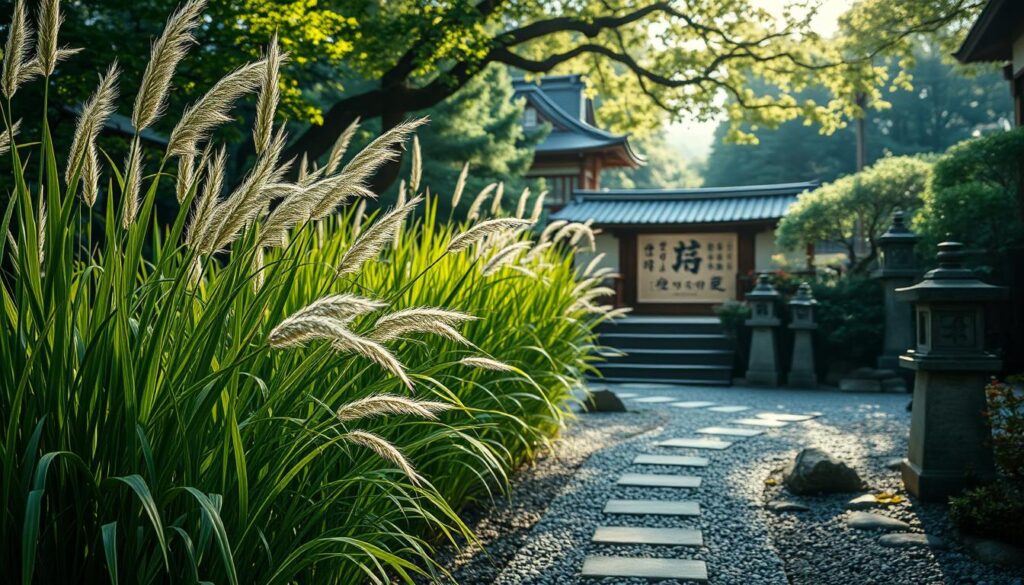
I love using Hakone grass in my japanese garden designs. This stunning perennial, also known as Japanese forest grass, brings a unique blend of texture and movement to any landscape. Native to Japan, it’s perfect for creating that authentic look in your own backyard oasis.
Hakone grass forms graceful, arching mounds of bright green foliage that sway gently in the breeze. As fall approaches, the leaves take on beautiful red tints, adding seasonal interest. It’s a versatile plant that works well in various garden styles, from traditional japanese gardens to modern rock gardens.
One of the things I appreciate most about Hakone grass is its adaptability. It thrives in USDA hardiness zones 5-9, making it suitable for many regions across the United States. This grass prefers rich, well-draining soil and can handle a range of light conditions, from full sun to full shade.
“Hakone grass is like a living mulch, adding movement and unique textures to the garden.” – Seattle Japanese Garden
When planning your garden, consider pairing Hakone grass with other shade-loving plants like hostas and ferns. For a striking contrast in your rock garden, try combining it with dark-leaved plants or placing it near water features.
| Characteristic | Details |
|---|---|
| Scientific Name | Hakonechloa macra |
| Mature Size | Up to 2 feet tall |
| Light Requirements | Full sun to full shade |
| Water Needs | Moist soil |
| Maintenance | Low |
With its graceful form and low maintenance needs, Hakone grass is an excellent choice for adding a touch of Japanese-inspired elegance to your garden. Whether you’re creating a serene meditation space or simply want to enhance your outdoor area, this versatile plant is sure to impress.
Plantain Lily (Hosta): Shade-Loving Beauty
I adore adding hostas to my japanese garden. These plants do great in shade and add elegance to any zen garden. With over 8,000 named types, hostas let me create beautiful landscapes.
Popular Hosta Varieties for Japanese Gardens
The ‘Gold Standard’ hosta is a top pick of mine. It’s great for USDA Hardiness Zones 3-8 and can reach up to 42 inches tall. The leaves display a mix of gold, light green, and variegated colors. Here’s a quick look at some key features:
| Feature | Details |
|---|---|
| Bloom Season | Mid Summer |
| Max Bloom Size | 1 inch |
| Price (1-Quart) | $25.00 (Discounted: $17.50) |
| Leaf Colors | Gold, Light Green, Variegated |
Planting and Care Instructions
When planting hostas in your japanese garden, pick a spot with partial to full shade. They do well in various conditions but like moist, well-draining soil. I plant my hostas at the same level they were in their containers.
Combining Hostas with Other Plants
In my zen garden, I enjoy pairing hostas with other shade-loving plants. Their lush foliage looks great against ferns, mosses, and Japanese maples. But remember, hostas are safe for humans but not for pets, so plan your garden with that in mind.
Mondo Grass: Ground Cover with Character
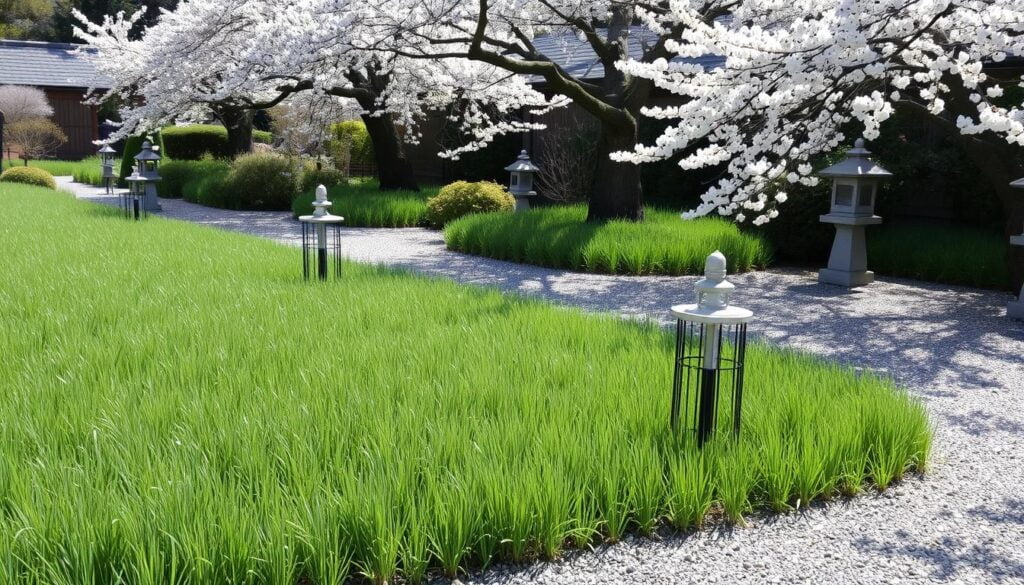
I adore using Mondo grass (Ophiopogon japonicus) in my japanese garden. It brings texture and character to the landscape. This plant grows up to 12 inches tall and does well in USDA hardiness zones 5-9, fitting many areas in the U.S.
Mondo grass likes full sun to partial shade and fits well in different light conditions. It spreads quickly through underground stolons, perfect for covering large areas fast. The leaves, up to 12 inches long, create a lush, green carpet that looks great with other garden elements.
In late summer, Mondo grass shows small white or lilac flowers, adding beauty. This plant follows the Wabi-Sabi idea, accepting change and imperfection. It’s great for creating visual space, or Ma, in garden designs.
- Height: 6-8 inches (bare root plants)
- Spread: Rapid
- Optimal zones: 6 (full sun), 7-10 (part shade to shade)
When adding Mondo grass to a rock garden, I think about its spread. It can spread fast, which is good and bad. In some spots, it might spread too much, so keeping it in check is important. This helps maintain the balance of your garden design.
Japanese Garden
I’ve always been drawn to the art of making a zen garden. Japanese gardens mix nature and architecture beautifully, creating a peaceful space. They show the beauty of Japanese philosophy and design.
Essential elements of a Japanese garden
A Japanese garden has a few key parts:
- Water features like ponds or streams
- Carefully placed rocks and stones
- Thoughtfully selected plants
- Architectural elements such as bridges or lanterns
Balancing plants, water, and stone
The beauty of a Japanese garden comes from its balance. Rocks stand for mountains, and water is like rivers or oceans. Plants bring life and color, but they’re used with care. This mix creates a small world that feels like nature.
Creating a sense of tranquility
A Japanese garden is meant to bring peace and calm. The sound of water, the feel of moss, and the movement of bamboo all add to the zen feeling. It’s a spot for quiet thought and meditation, away from daily life’s noise.
| Element | Symbolism | Common Examples |
|---|---|---|
| Water | Life force, purity | Koi ponds, streams |
| Stones | Mountains, stability | Rock gardens, stepping stones |
| Plants | Nature, seasons | Maple trees, bamboo, moss |
| Structures | Human touch, harmony | Tea houses, bridges, lanterns |
Cherry Trees: Seasonal Splendor
Cherry blossoms are the stars of Japanese gardens. They turn landscapes into magical places every spring. Their delicate pink and white blooms seem to dance in the wind.
The Yoshino Cherry Tree (Prunus x yedoensis) is a favorite in Japanese gardens. It can grow up to 35 feet tall and does well in USDA Hardiness Zones 5-8. This tree prefers full sun and soil that drains well but stays moist.
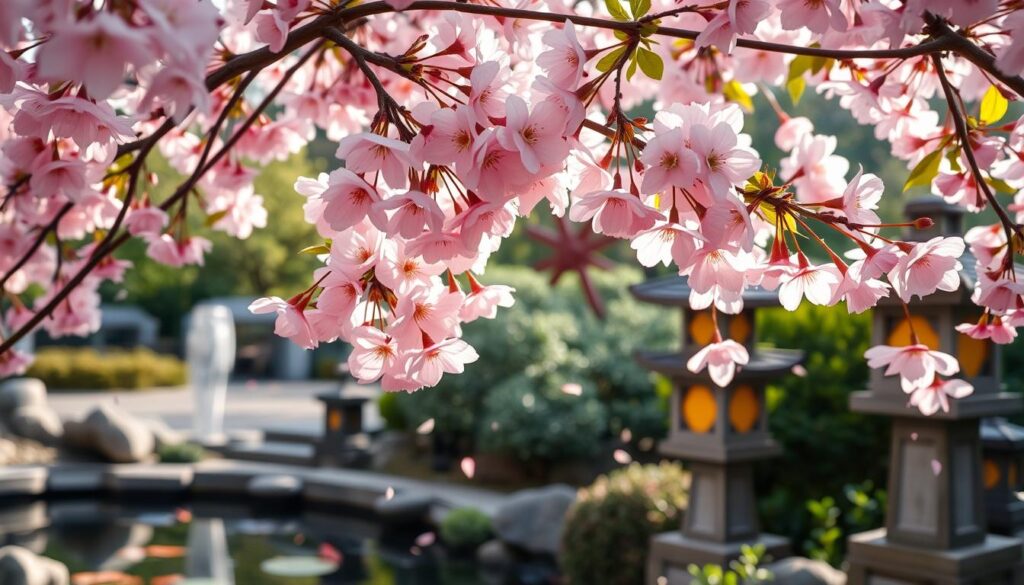
- ‘Akebono’: Known for its pale pink flowers
- ‘Shidare-Yoshino’: A weeping variety with cascading branches
- ‘Somei-Yoshino’: Features white flowers with a hint of pink
Cherry trees are not just pretty; they have a rich history and culture. In 1930, Seattle got 4,000 flowering cherry trees from Japan as a gift. This started a tradition that still goes on today.
When designing your Japanese garden, remember cherry trees are more than spring beauties. They look good all year and are great with winter plants like Winter Jasmine or Lenten Roses.
| Cherry Tree Characteristics | Yoshino Cherry | ‘Akebono’ | ‘Shidare-Yoshino’ |
|---|---|---|---|
| Flower Color | Pink to White | Pale Pink | White to Light Pink |
| Tree Shape | Upright, Spreading | Vase-shaped | Weeping |
| Bloom Time | Early Spring | Mid-Spring | Early to Mid-Spring |
| Height (Mature) | 30-35 feet | 25-30 feet | 15-20 feet |
Incorporating Water Features with Plants
In my Japanese garden, I enjoy mixing water features with plants. This mix makes a calm place great for relaxing. Water in Japanese gardens stands for purity and new beginnings.
Japanese Iris for Pond Edges
Japanese iris (Iris ensata) grows well by my koi pond’s edge. These flowers bring color and beauty to the water. The ‘Rose Queen’ variety, with pink petals and gold highlights, is my favorite.
Aquatic Plants for Koi Ponds
Koi ponds are key in Japanese gardens. I’ve added water lilies and lotus to my pond. These plants are not just pretty; they keep the water clean for my koi.
Creating a Harmonious Waterscape
To make my zen garden peaceful, I balanced plants, rocks, and water. Stone basins (Tsukubai) are useful and look good. A bamboo fountain adds a calming sound and draws birds.
| Water Feature | Purpose | Plants |
|---|---|---|
| Koi Pond | Focal point, fish habitat | Japanese iris, water lilies |
| Bamboo Fountain | Sound, visual interest | Moss, ferns |
| Stone Basin (Tsukubai) | Purification, aesthetics | Dwarf bamboo, evergreen shrubs |
By blending these elements, I’ve made a serene oasis. It reflects the spirit of a traditional Japanese garden. Water features and plants together add life and calm to my garden.
Bamboo: Vertical Interest and Privacy
Bamboo brings a magical touch to japanese gardens. Its tall, slender stalks add a sense of vertical drama. In zen gardens, it acts as a living privacy screen, keeping the peaceful inside safe from the outside.
Bamboo stands for strength and flexibility in Japanese culture. It’s ideal for garden design, showing qualities like purity and gracefulness. Walking through a bamboo grove, I feel a deep connection to nature and a sense of timeless peace.
For those wanting to add bamboo to their gardens, here are some popular types:
- Hedge Bamboo: Grows 3-5 meters tall, ideal for screens
- Inyo-Chiku: Reaches 3-5 meters, perfect for lush hedges
- Ma-Dake: Can grow up to 20 meters, great for larger gardens
- Kuro-Chiku: Reaches 7 meters with striking black canes
Bamboo grows fast and needs regular pruning. I suggest choosing clumping varieties to prevent spreading. With the right care, bamboo will turn your garden into a serene oasis, like the most beautiful japanese gardens.
Moss: Creating a Lush Carpet
Moss is a key part of Japanese gardens, adding a soft, lush carpet. It brings life to walkways and rock gardens. With over 10,000 species, moss is versatile for garden design.
Types of Moss Suitable for Japanese Gardens
There are two main types of moss ideal for Japanese gardens:
- Acrocarps: Upright-growing mosses
- Pleurocarps: Creeping mosses that form dense mats
Both types are great for rock gardens, giving a natural, aged look. I like mixing them for texture and interest in my Japanese garden designs.
Cultivating and Maintaining Moss
Moss grows slowly, about 0.25 to 2.5 inches a year. To grow moss:
- Choose a shady spot
- Keep the soil moist and acidic
- Collect moss by scooping, scraping, or raking
- Plant it in your garden
- Water it often to keep it moist
Incorporating Moss in Rock Gardens
Moss and rocks are a great match in Japanese gardens. I once used over 7,000 pounds of stone for a stunning rock garden. The moss grew between and around the rocks, softening their look and creating a natural feel.
| Feature | Benefits |
|---|---|
| Moss | Absorbs 20x its weight, anti-bacterial, attracts fireflies |
| Rocks | Creates steps, marks paths, looks like natural outcrops |
| Combination | Improves the look, saves water, filters pollution |
By mixing moss with rocks, you can make a Japanese garden that’s peaceful and beautiful.
Complementary Elements: Rocks, Lanterns, and Pagodas
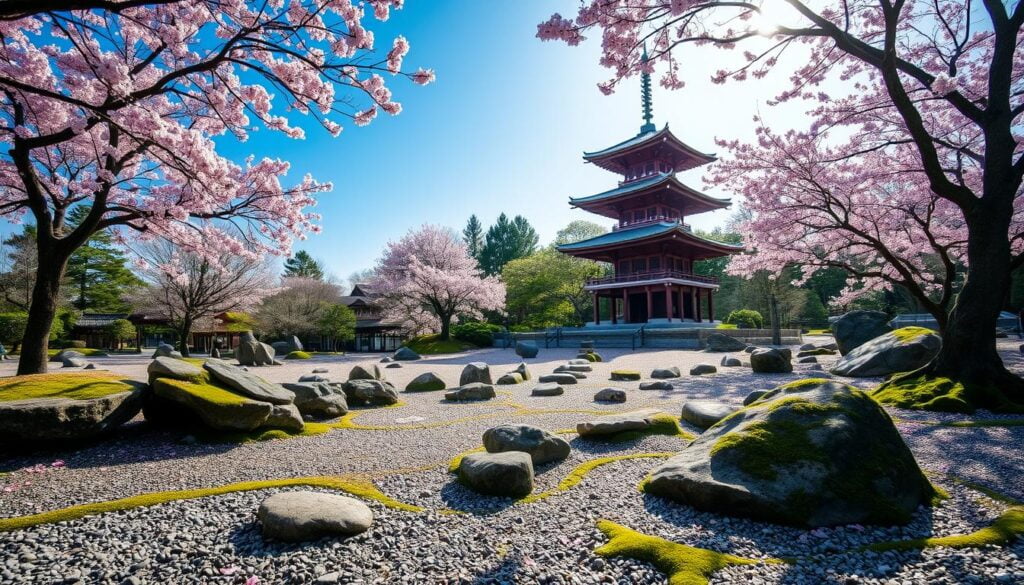
I love how Japanese gardens mix nature with human-made elements. Rocks, lanterns, and pagodas add balance and harmony. A well-designed rock garden can make you feel peaceful.
Rocks are key in Japanese gardens. They look like mountains or islands, creating a small landscape. Carefully placed stones bring a sense of stability and permanence.
Stone lanterns add traditional Japanese architecture to the garden. They come in many styles, each with its own meaning. For example, the Yukimi-Gata lantern looks like it’s wearing a snow cap, great for winter.
Pagodas are inspired by Shinto shrine architecture. They have multiple tiers, symbolizing nature’s five elements: earth, water, fire, wood, and metal. When picking a pagoda, think about its size and where it will be seen. It should fit your space and be visible from where you sit.
- Pagoda statues are usually made of stone, wood, or bronze
- Lanterns often have an odd number of tiers, like three or five
- The flame in a lantern stands for Buddha’s teachings
Adding these elements thoughtfully makes a Japanese-inspired garden beautiful and meaningful. The goal is to create a calm place for meditation. With rocks, lanterns, and pagodas, your garden will be a peaceful escape from the world.
Conclusion
I’ve looked into the world of Japanese gardens, starting from 1339 at the Saihō-ji temple in Kyoto. These gardens have grown over the years, mixing nature and art for peace. They’ve changed from the Asuka period to today, showing Japan’s unique landscapes and seasonal beauty.
When making your own Japanese garden, think about water features, rocks, and gravel. Evergreen plants are the base, with moss and dry gardens adding more depth. Pine trees mean long life, azaleas show nature’s power, and vermilion keeps evil spirits away. These elements make a peaceful and balanced space.
Japanese gardens have become popular in the West, becoming a key part of bigger landscapes. You can make your own peaceful spot, big or small, using Japanese garden ideas. By picking the right plants and adding symbols, you can make a place that’s beautiful and calming.
FAQ
What are the key principles of Japanese garden design?
What plants are suitable for a Japanese-inspired garden?
How do I care for Japanese maples?
What are some popular Camellia varieties for Japanese gardens?
How do I incorporate water features with plants in a Japanese garden?
How do I create a lush moss carpet in my Japanese garden?
What complementary elements can I include in a Japanese garden?
Source Links
- Best plants for Japanese gardens – 10 elegant choices for this soothing backyard style
- 9 Best Plants for a Japanese Garden (with Pictures & Care Guides) – Trees.com
- How I Found the Meaning of Life in a Japanese Garden | By Gustavo Razzetti
- Poem and a Picture: Japanese Gardens as Reflections of the Natural World — Deeper Japan
- Best Japanese & Zen Garden Fountains 2024: Luxury Water Features Selections – ZenFusionHome
- How to appreciate Japanese gardens
- Camellia Collection — Seattle Japanese Garden
- In Bloom: Camellia japonica — Seattle Japanese Garden
- Grasses & Grasslike plants in the Seattle Japanese Garden — Seattle Japanese Garden
- How to Plant, Grow, and Care for Japanese Forest Grass
- How to Plant, Grow, and Care for Hakone Grass – Complete Guide
- Hosta ‘Gold Standard’ Plantain Lily
- How to Grow and Care for Hostas (Plantain Lilies) | Gardener’s Path
- Embrace the Tranquility of Japanese Garden Design
- Ophiopogon japonicus (bare root plant)
- Hours & Admission – Portland Japanese Garden
- Home – The Japanese Garden
- Japanese Tea Garden at Gardens of Golden Gate Park
- Japanese Ornamental Cherry Tree Acquisitions
- cherry blossoms – Only In Japan
- Japanese Gardens: Winter Landscapes for Mind, Body and Soul
- How to create a serene Tsukubai Japanese Water Garden
- Designing a Japanese-Inspired Zen Garden with Water Features
- Zen Garden Fountain: 3 Water Feature Ideas from Japanese Gardens –
- The Artistry of Japanese Bamboo Grove Gardens: Inspiration for Landscape Design
- Japanese Garden Bamboo Ultimate Guide: Top Species & Varieties – ZenFusionHome
- How to Use Moss in the Landscape
- The Magic of Moss
- Creating More Zen in Your Garden with Pagoda Statues
- Types of Japanese Stone Lanterns: Pagoda style – ZenFusionHome
- Japanese garden
- The Healing Nature of Japanese Gardens

